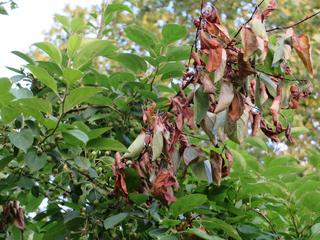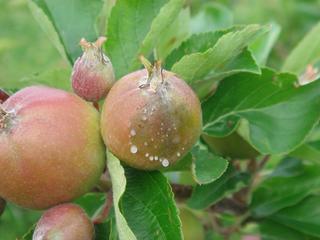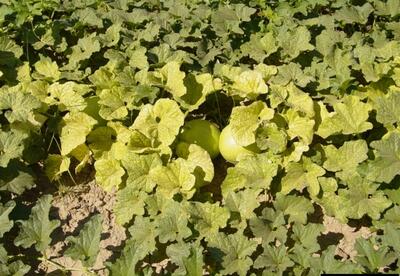
Figure 1. Multiple plants showing symptoms of fire blight in young apple orchard. Image courtesy of Janna Beckerman, Purdue University.
---FOR IMMEDIATE RELEASE---
Agdia, Inc. (Elkhart, IN) has commercialized an ImmunoStrip® assay for detection of Erwinia amylovora, the causal agent of fire blight on apple and pear.
Erwinia amylovora is a gram-negative, rod-shaped bacterium that causes fire blight in several members of the Rosaceae family, including Malus (apple and crabapple) and Pyrus (pear). This pathogen is native to North America and is a quarantined invasive species in the European Union, subject to phytosanitary controls. Entire orchards can become infected under conditions optimal for inoculum dissemination and disease progression (Figure 1.). Therefore, fire blight is considered a major threat to apple and pear production throughout the world.

Fire blight infections typically occur in the spring. Open flowers are the most common infection courts and remain susceptible until petal drop. Thereafter, infections can potentially spread to leaves, fruit, twigs, scaffolding limbs, trunks and root systems, illing highly susceptible hosts. Symptoms of fire blight vary depending on the host; however, symptoms generally include water soaking, stem and leaf necrosis (Figure 2.), and trunk and collar cankers. Shoot tips may wilt rapidly forming the characteristic “shepherd’s crook”. Active infections produce amber-colored bacterial ooze that exudes from cankers and fruit (Figure 3.). This ooze is the primary inoculum and is disseminated locally by pollinating insects, wind and splashing water. Long-distance dispersal of inoculum is via interstate movement of infected plant parts.

Agdia’s new E. amylovora ImmunoStrip® was screened against a diverse collection of isolates, and it detected 100% of true positives, including isolates infecting Rubus spp. Moreover, this assay was shown to reliably detect Erwinia pyrifoliae, a closely related species known to cause tissue necrosis on pear in Asia and strawberries in Europe. Agdia states no cross-reactivity was observed for several potential cross-reactors, including Pseudomonas spp., Xanthomonas spp. and Erwinia spp., non-pathogenic on rosaceous hosts. This assay was designed to be used on leaf, stem, bark, fruit tissue and pure culture.
Agdia’s ImmunoStrip® platform provides end-users with a high level of utility. Samples can be tested in the field by those having no previous diagnostic experience, and results are visualized within 30 minutes. The introduction of Agdia’s E. amylovora ImmunoStrip® expands their catalog to 43 products on this platform. High levels of market demand for field-deployable, plant pathogen detection products have driven this output, and Agdia maintains they will continue to expand their product catalog.
The E. amylovora ImmunoStrip® is sold in kits of 5 or 25 strips, and kits include everything necessary to perform a test. Agdia provides a one-year warranty on purchased kits. Diagnostic assays for the detection of E. amylovora are also available in enzyme linked immunosorbent assay (ELISA) formats. For more information on these products, in addition to Agdia’s full catalog of pathogen detection products, visit the company’s website at www.agdia.com, e-mail info@agdia.com, phone 1-574-264-2615 (toll-free 800-622-4342) or fax 1-574-264-2153.
ImmunoStrip® is a registered trademark of Agdia, Inc.
###





